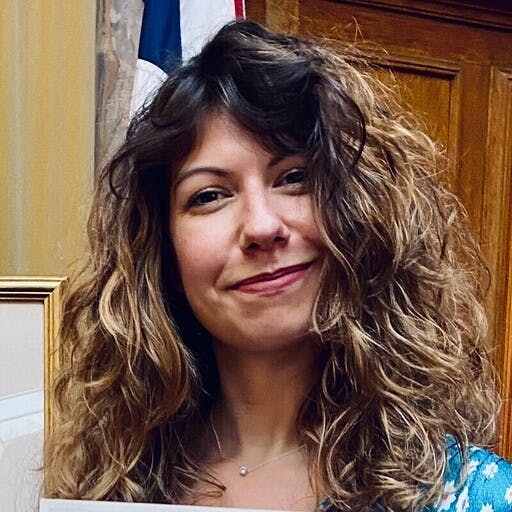Blending creativity, collaboration and a passion for journalism, our Senior Product Designer Erika Cellai, reflects on her path to the FT, how her role has evolved, and what it means to design products that empower readers and support trustworthy reporting.

Can you tell us a little about your career path and what led you to become a Senior Product Designer here?
I studied Product Design in Florence, completing a BA and MA, then spent a year in Scotland freelancing as a graphic designer. London opened more doors: a stint at the Condé Nast College rekindled my love for digital products, which led to four years there where I grew from hands-on designer to owning bigger, cross-functional problems. That blend of craft, editorial context and commercial thinking set me up for my move to the FT as a Senior Product Designer.
What drew you to the FT and our product design team?
After Condé Nast I joined a couple of start-ups in e-commerce, intrigued by how shopping journeys and publishing experiences overlap. I soon realised I missed the rhythm and purpose of journalism, and I’ve long admired the FT’s craft and authority. In a climate of misinformation, using my skills to support trustworthy reporting felt both meaningful and motivating,so the FT’s product design team was the natural destination.
How has your role evolved since joining the company?
Since joining two years ago, my focus has broadened from delivering features to shaping problems with the newsroom and product partners. I now lead discovery and experimentation in the article experience, bring evidence into prioritisation, and mentor designers while contributing to our design system standards. It’s a shift from “what are we shipping?” to “what outcomes are we driving for readers and the business?”
What’s been one of your most exciting or challenging projects so far, and what impact did it have on our users or business?
Two stand out. Working closely with the newsroom, we redesigned Live Blogs ahead of major elections–streamlining hierarchy and update tools so readers could grasp developments faster and journalists could publish with less friction. More recently we launched “Ask an Expert”, a format that connects readers directly with our journalists; it has deepened engagement and built trust by making expertise more accessible.
How do you balance creativity with practicality when designing products?
I start wide-drawing inspiration from beyond news and beyond digital–then quickly funnel ideas through feasibility, user needs, business goals and timelines. Lo-fi prototypes and early engineering chats help me land the elegant solution we can actually ship. The trick is to “kill your darlings” with kindness: keep the intent, simplify the execution.
Product design is highly collaborative — how do you work with engineers, product managers, and other teams?
Good collaboration starts with empathy: I spend time in engineers’ and PMs’ worlds, ask questions, and listen. I’m careful to respect boundaries–deep enough to understand constraints but not so deep I blur roles., I also take ownership of design quality end-to-end. Clear specs, shared rituals and quick prototypes create trust; caring is sharing, and it makes delivery smoother.
What’s something you appreciate about the way the team tackles challenges together?
I love that everyone plays their part and backs each other to reach the best outcome. When plans change, we rally rather than point fingers, learn through tight feedback loops, and try again with clearer intent. That steady, team-first mindset means even the tough weeks move us forward.
How does the company support you in staying up to date with design trends and tools?
We’re encouraged to attend design and research events, which keeps skills sharp and networks strong. Internally we run critiques and share-outs, and we’ve recently gained access to Figma’s AI features, which are useful for exploration and speeding up the nuts and bolts. It’s a healthy mix of community, tools and practice.
What advice would you give to designers who aspire to move into senior roles?
Don’t rush it.Focus on learning broadly and honing your craft. Ship real work, and ask senior designers for guidance – staying humble speeds up your growth. Seniority isn’t a title; it’s how you show up:clear thinking, calm communication and consistent outcomes through others. Enjoy the journey; the foundation you lay early is what makes you effective later.
What excites you most about the future of design and technology at the FT?
Publishing is entering its second big shift: after print-to-digital, AI is reshaping how we create and consume. Reader behaviours are changing again, and the FT can can lead with responsible, human-centred design. Being in the Article Experience team puts me at the heart of that challenge. Honestly, I couldn’t be in a more exciting place.
What do you wish more people knew about working at the FT?
It’s a pivotal moment for our industry and there’s real scope to make a dent in the world through trustworthy journalism. What I value most is the mix of craft, rigour and collaboration: people care deeply about the work, and there’s genuine appetite to experiment where it helps readers. I’m excited about where we’re heading and confident about the future.
Outside of work, what inspires your creativity?
I’m endlessly drawn to vintage fairs, flea markets and car boot sales–anything with heritage and a story to tell. It’s a lovely counterbalance to working in tech. Art is my other big love: galleries, exhibitions and museums are my happy place (I once spent seven hours in the Louvre–no regrets!). I also rely on Pilates and long walks in nature by the sea, in the forest or up a mountain. Both recharge me; the calm and beauty are unrivalled and always reset my perspective.
BUILD A NEWSWORTHY CAREER AT THE FT. FIND YOUR NEXT ROLE WITH US.